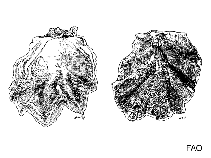Crassostrea tulipa (Lamarck, 1819)
West African mangrove oyster| Native range | All suitable habitat | Point map | Year 2050 |

|
| This map was computer-generated and has not yet been reviewed. |
| Crassostrea tulipa AquaMaps Data sources: GBIF OBIS |
Google image | No image available for this species;
drawing shows typical species in Ostreidae.
Classification / Names Κοινά ονόματα | Συνώνυμα | CoL | ITIS | WoRMS
Bivalvia | Ostreida | Ostreidae
Environment: milieu / climate zone / εύρος βάθους / distribution range Οικολογία
; Υφάλμυρο. Tropical; 23°C - 31°C (Αναφ. 112235); 21°N - 24°S, 61°W - 14°E (Αναφ. 111917)
Distribution Χώρες | Περιοχές FAO | Οικοσυστήματα | Παρουσίες | Εισαγωγές
Atlantic Ocean: From Mauritania to Angola and from Venezuela to Brazil.
Length at first maturity / Μέγεθος / Weight / Age
Γεννητική Ωρίμανση: Lm ? range ? - ? cm
Life cycle and mating behavior Γεννητική Ωρίμανση | Αναπαραγωγή | Γεννοβολία | Eggs | Γονιμότητα | Larvae
Main reference
Αναφορές | Συντονιστής | Συνεργάτες
Ranson, G. 1960 Les Prodissoconques (coquilles larvaires) des Ostréidés vivants. Bulletin de l'Institut Océanographique (Monaco) 1183: 41 pp. (Αναφ. 83479)
IUCN Red List Status
(Αναφ. 130435: Version 2025-1)
CITES status (Αναφ. 108899)
CMS (Αναφ. 116361)
Threat to humans
Human uses
αλιεία: Εμπορικό(ά)
| FishSource | Η θάλασσα γύρω μας
Εργαλεία
Περισσότερες πληροφορίες
Διαδικτυακές πηγές
BHL | BOLD Systems | CISTI | DiscoverLife | FAO(Publication : search) | Fishipedia | GenBank (genome, nucleotide) | GloBI | Gomexsi | Google Books | Google Scholar | Google | PubMed | Δέντρο Ζωής | Wikipedia (Go, αναζήτηση) | Zoological Record



